When it comes to sharing a long and joyful life with a pup, choosing from long-lived dog breeds is a smart move for many pet parents. While giant breeds tend to have shorter lifespans, smaller dog breeds and medium-sized dogs often live longer, sometimes well into their late teens! A mix of genetics, lifestyle, and quality veterinary care plays a huge role in dog longevity.
Did you know the Guinness World Records once named an Australian Cattle Dog the longest living dog, reaching a whopping 29 years? While that’s rare, many breeds typically live 13–16 years, especially when kept at a healthy weight and given regular exercise. The key isn’t just long life—it’s a happy, healthy one.
Whether you’re into tiny dogs with big personalities or active herders with endurance to match, there’s a breed that fits your pace and promises years of loyal companionship. Let’s explore the pups that tend to live longest—and how to help them thrive.
Long-Lived Dog Breeds
1. Miniature Schnauzer
Miniature Schnauzers are spunky, medium-sized dogs with a reputation for long and healthy lives. With an average lifespan of 12–15 years, they’re among the longest-lived dog breeds loved by families worldwide.
They’re naturally sturdy and, with regular exercise and mental stimulation, they age gracefully. Pet parents who stay on top of their veterinary care and nutrition can often see their Schnauzer thrive well into their teens.
These dogs were originally bred to guard farms and chase vermin, which explains their boldness and drive. That working background also means they’re happiest with structure and engagement.
Their distinctive wire-haired coat is low-shedding but needs routine grooming. Good dental hygiene is essential, as dental disease can creep in with age.
Miniature Schnauzers may be small, but their bark, brains, and energy are anything but. They’re alert, loyal, and great with other dogs and children alike.
This breed is the total package—smart, tough, and long-lasting. With proper love and care, they make vibrant companions for over a decade.
Fun Fact
The Miniature Schnauzer is the only terrier not from the British Isles—born and bred in Germany, with a signature beard to prove it!
2. Parson Russell Terrier
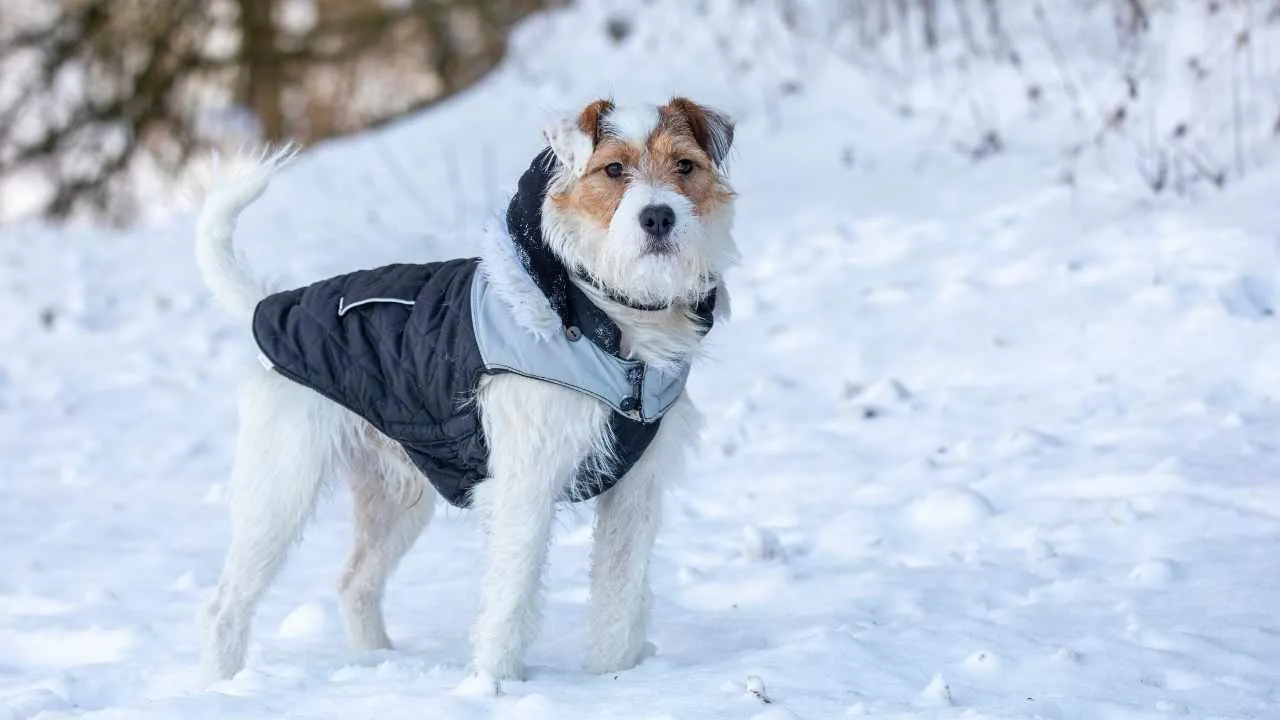
The Parson Russell Terrier is a high-energy, long-living terrier known for its playful nature and loyalty. With an average lifespan of 13–15 years, it’s one of the more long-lived dog breeds in the terrier family.
Originally bred for fox hunting, this tiny dog is fearless, fast, and incredibly agile. Its zest for life means it thrives with regular exercise and a job to do.
Parsons are closely related to Jack Russell Terriers, another breed that can live longer than most dogs their size. Both benefit from mental stimulation and activities that tap into their working instincts.
They do best in homes with structure and proper training to manage their enthusiasm. While friendly, they need boundaries to avoid becoming overly independent.
Health-wise, they’re generally sturdy but may be prone to dental disease and hip dysplasia as they age. Routine veterinary care keeps them feeling youthful.
This loyal breed is ideal for active pet parents who love a challenge and lots of doggy affection. With the right care, they’ll bring fun and energy into your home for years.
Fun Fact
Despite their size, Parson Russells were once expected to keep up with horseback riders during fox hunts—no lazy laps here!
3. Australian Shepherd
Australian Shepherds are smart, soulful, and built for endurance. They typically live 12–15 years, making them a favorite among active families seeking a longer-lasting companion.
Though not small, this medium-sized dog is impressively agile and thrives on regular exercise and daily engagement. Their sharp mind and athleticism also help keep age-related health problems at bay.
Originally bred to herd livestock in the American West, they still have that drive and devotion today. Their loyalty is unmatched, making them one of the greatest family pets out there.
They do require mental stimulation, training, and time with their humans to avoid boredom or anxiety. Left alone too long, they may become destructive or vocal.
Health-wise, Aussies can develop conditions like progressive retinal atrophy or hip issues, but responsible breeding and early screening help. Keeping a healthy weight also supports their long lifespan compared to some larger breeds.
With proper care, Aussies can enjoy a long, vibrant life full of purpose and companionship. They’re as joyful in their teens as they are as a puppy, just with a little more wisdom.
Fun Fact
Despite the name, the Australian Shepherd was developed in the U.S.—its name comes from the Basque shepherds who brought them from Australia!
4. Dachshund
Dachshunds, affectionately known as “wiener dogs,” are small but mighty dogs with surprisingly long lifespans—often reaching 12–16 years, and sometimes even beyond.
Their unique body, with short legs and a long back, was originally bred for hunting badgers. That fearless hunting spirit still shows in their bold and lively temperament today. They’re independent thinkers with big personalities packed into small frames.
While their sturdy nature contributes to their longevity, back problems such as intervertebral disc disease (IVDD) are a concern. Preventing high jumps, maintaining a healthy weight, and providing proper support are essential for spinal health.
Dachshunds enjoy a good walk and interactive play. Without it, they can become bored and vocal. Mental stimulation is key, as these little hounds are clever and love a challenge.
Grooming needs vary by coat type—smooth, longhaired, or wirehaired—but all need regular dental care to avoid age-related health issues.
Dachshunds are a favorite among families for their loyalty and longevity. With attentive care, they can bring years of spunky companionship.
Fun Fact
The name “Dachshund” means “badger dog” in German—perfect for this feisty little digger with a big bark and a long life.
5. Affenpinscher
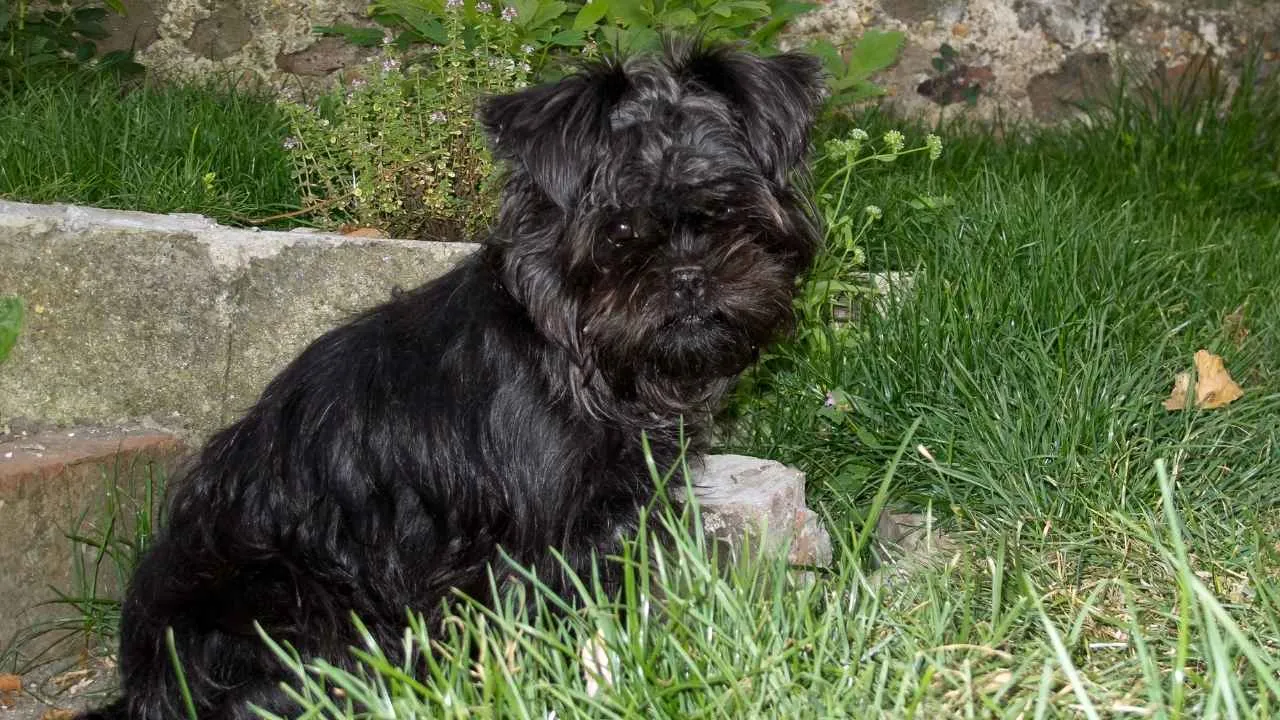
The Affenpinscher is a small, wiry-haired dog with a big personality and an average life expectancy of 12–15 years. These little charmers are full of mischief and affection, making them delightful lifelong companions.
Often called the “monkey dog” due to their expressive faces, Affens were bred to chase rats and vermin—an instinct that gives them their bold and curious nature even today. They’re lively and alert, always ready for action.
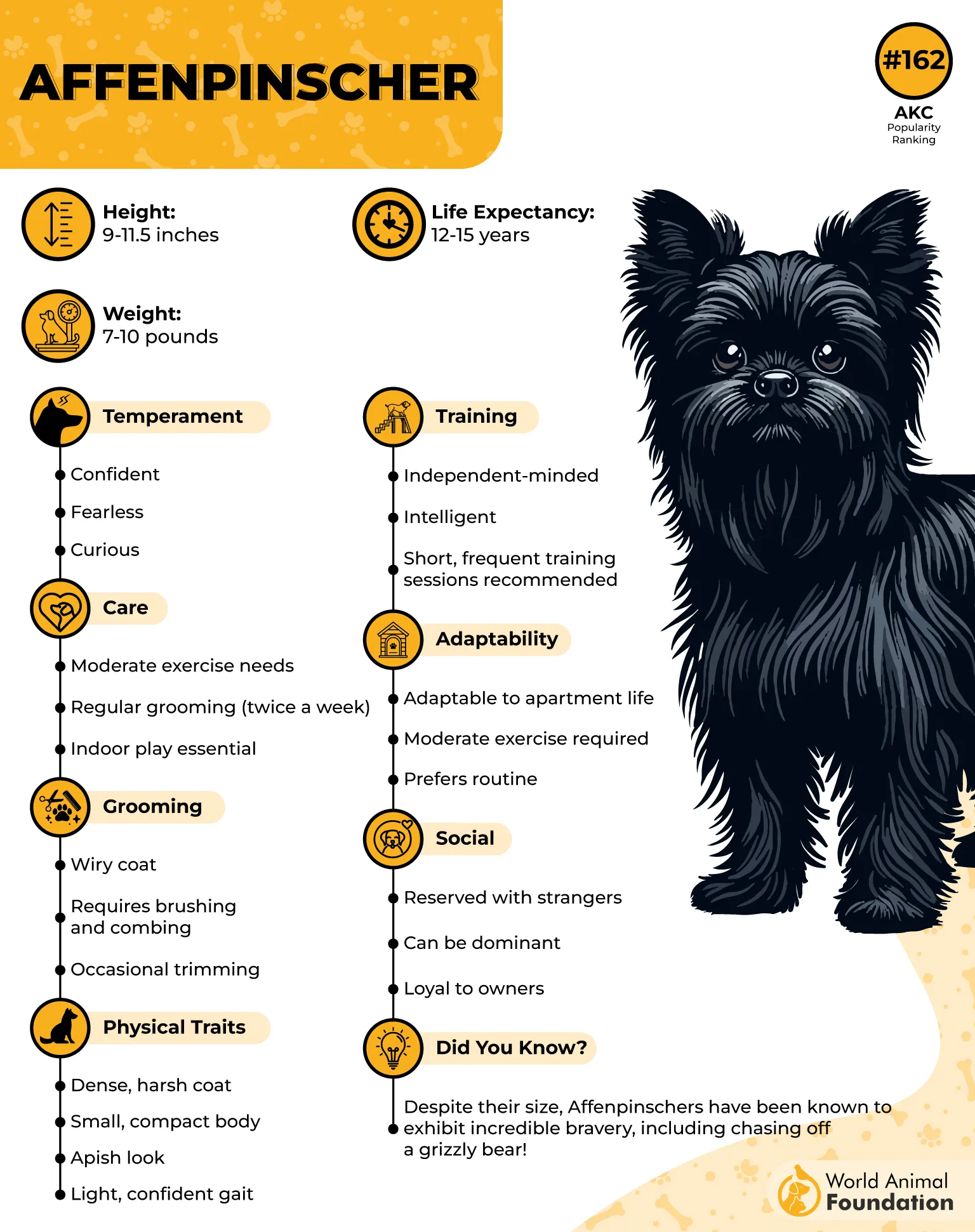
Though small, they are spirited and do best with regular exercise and play. While not hyper, they enjoy staying active and mentally engaged to avoid becoming bored or stubborn.
Health conditions to watch for include heart disease, hip dysplasia, and dental problems. A strong relationship with a trusted veterinarian can help spot early signs and extend their lifespan.
Their coat requires consistent grooming to prevent mats, but they’re considered low-shedding, ideal for allergy-conscious dog lovers. A clean, brushed Affen is a happy Affen.
Fun Fact
Despite being tiny, Affenpinschers often think they’re giant watchdogs. Their bold bark might fool you into thinking there’s a much bigger dog in the house!
6. Shiba Inu
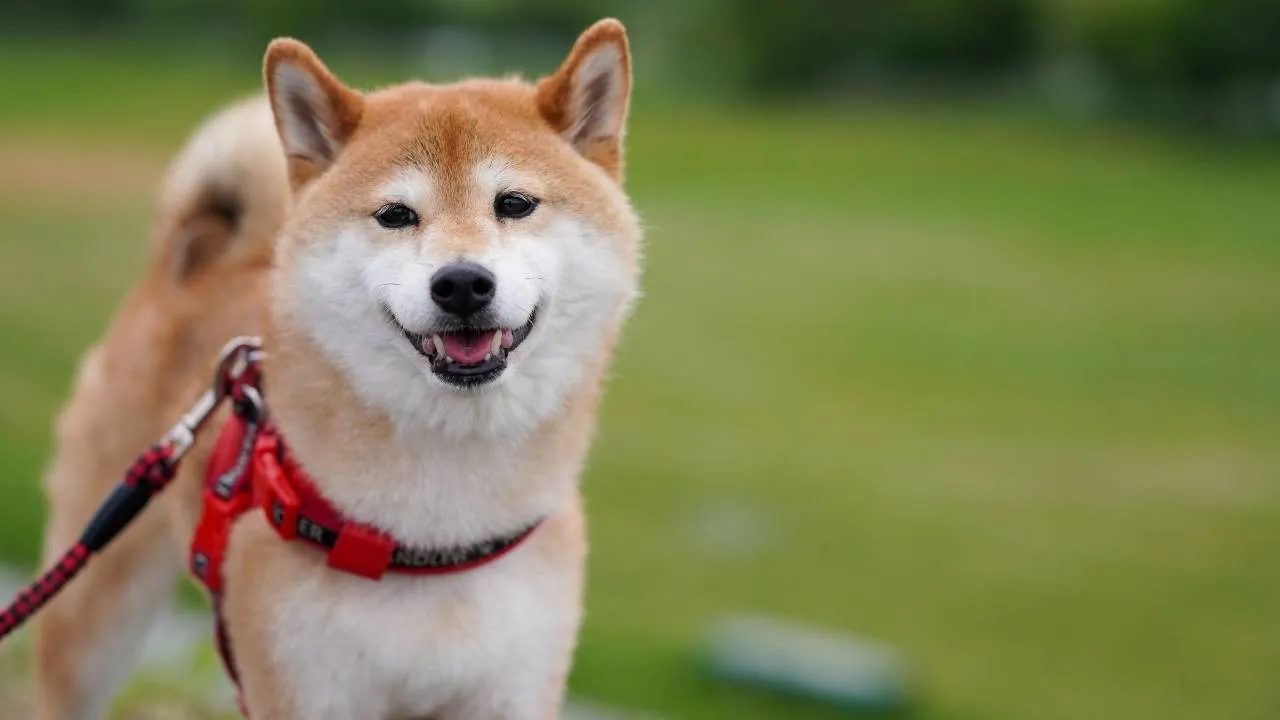
Independent and foxlike, the Shiba Inu is a bold little dog from Japan that typically lives 13–16 years, making it one of the more robust and long-lived dog breeds around.
Originally bred to hunt in mountainous terrain, Shibas are agile and self-assured. Their energetic nature means they benefit from daily exercise and mental stimulation, especially puzzle toys and structured walks.

While affectionate with their family, they’re not overly clingy and may be aloof with strangers. Their signature “Shiba scream” is infamous—dramatic vocalizations when they’re excited, frustrated, or just want attention.
Shibas are generally healthy but can face health issues such as allergies and patellar luxation. Consistent vet visits and weight control help support their life span into the senior years.
With their clean habits and minimal doggy odor, they’re often compared to cats. However, their independent streak makes early training and socialization essential for a balanced adult dog.
Fun Fact
The Shiba Inu is the most popular companion dog in Japan and one of the few ancient breeds that still exists today in near-original form.
7. Miniature Pinscher
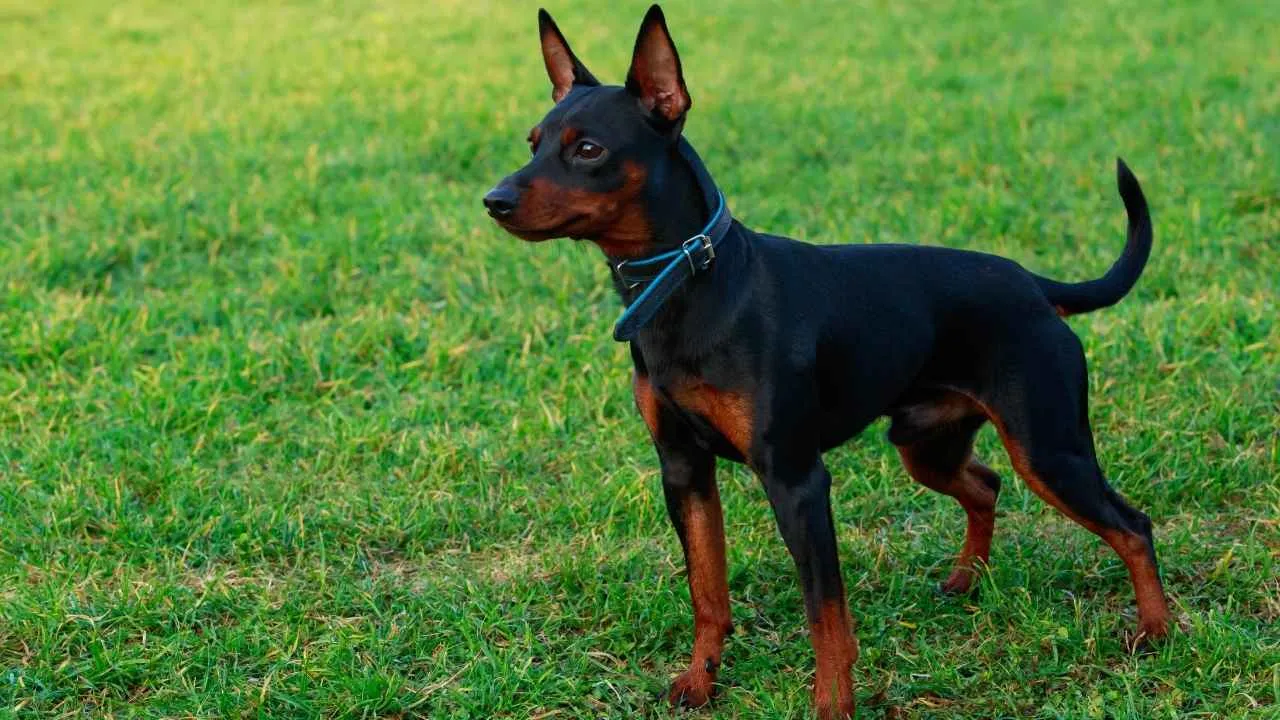
Often mistaken for a mini Doberman, the Miniature Pinscher is actually its own ancient breed—small, sleek, and full of spirit. With a typical lifespan of 12–16 years, this toy breed is built for both energy and longevity.
Mini Pins are known for their high confidence and bold personality. Though small, they carry themselves like large dogs and require regular exercise to stay healthy and balanced.
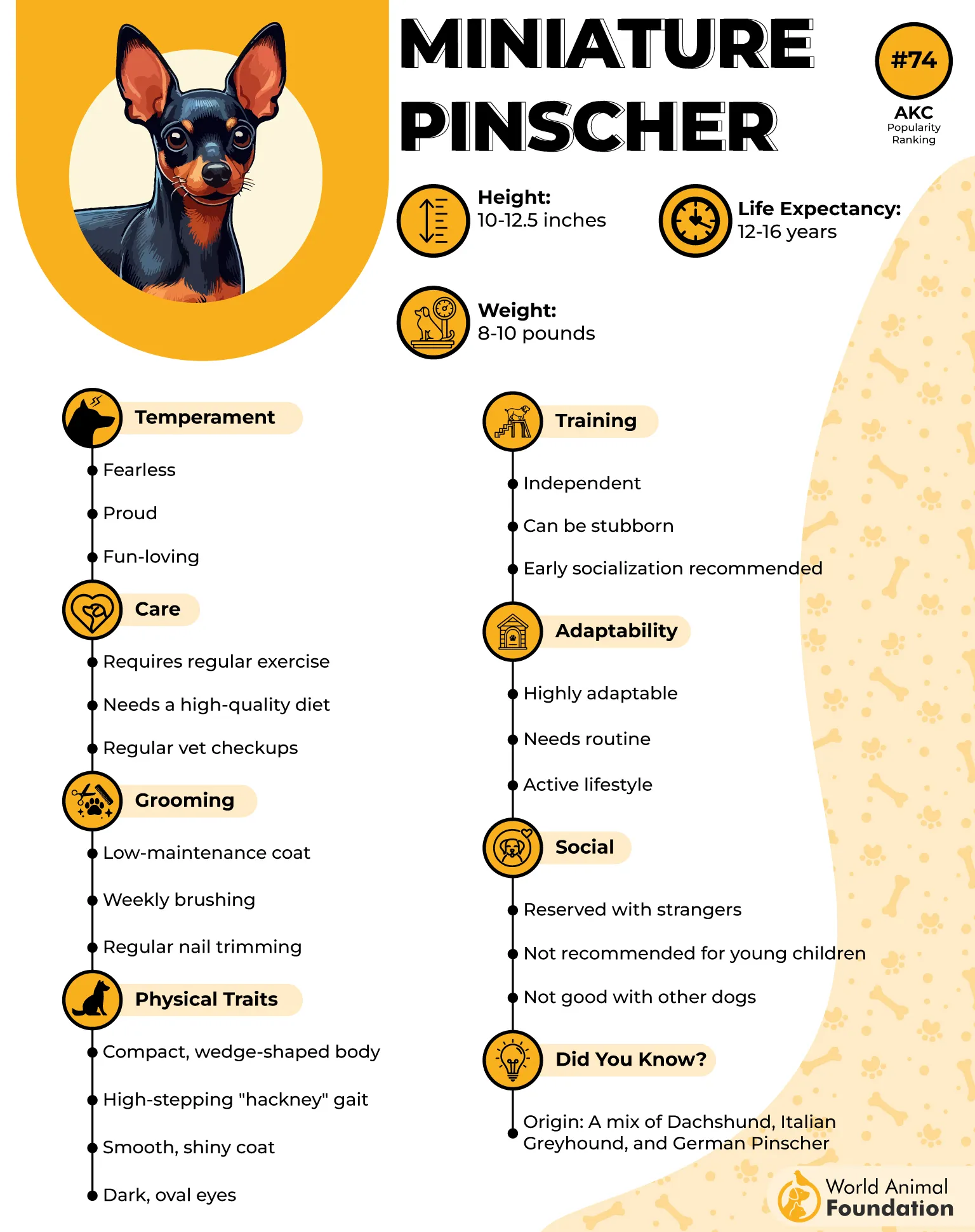
Their alertness and loyalty make them great watchdogs, though early training is essential to keep barking in check. They do best with structured routines and consistent guidance.
Health-wise, Miniature Pinschers are generally sturdy, but they can be prone to heart disease and dental issues. Routine veterinarian checkups and proper dental care support a long, healthy life.
Their short, glossy coat is low maintenance, which suits busy owners. However, don’t let their size fool you—these dogs are energetic and love to explore, making them great companions for active lifestyles.
Fun Fact
The Miniature Pinscher is often called the “King of Toys” thanks to its fearless attitude packed into a pint-sized frame.
8. Australian Cattle Dog

The Australian Cattle Dog, often nicknamed the “Blue Heeler,” is one of the most rugged and long-lived dog breeds, with many reaching 13–16 years and even older with proper care.
Bred for herding cattle in the tough Australian outback, these dogs are intelligent, strong, and need lots of mental and physical stimulation. They’re happiest with a job to do and space to roam.
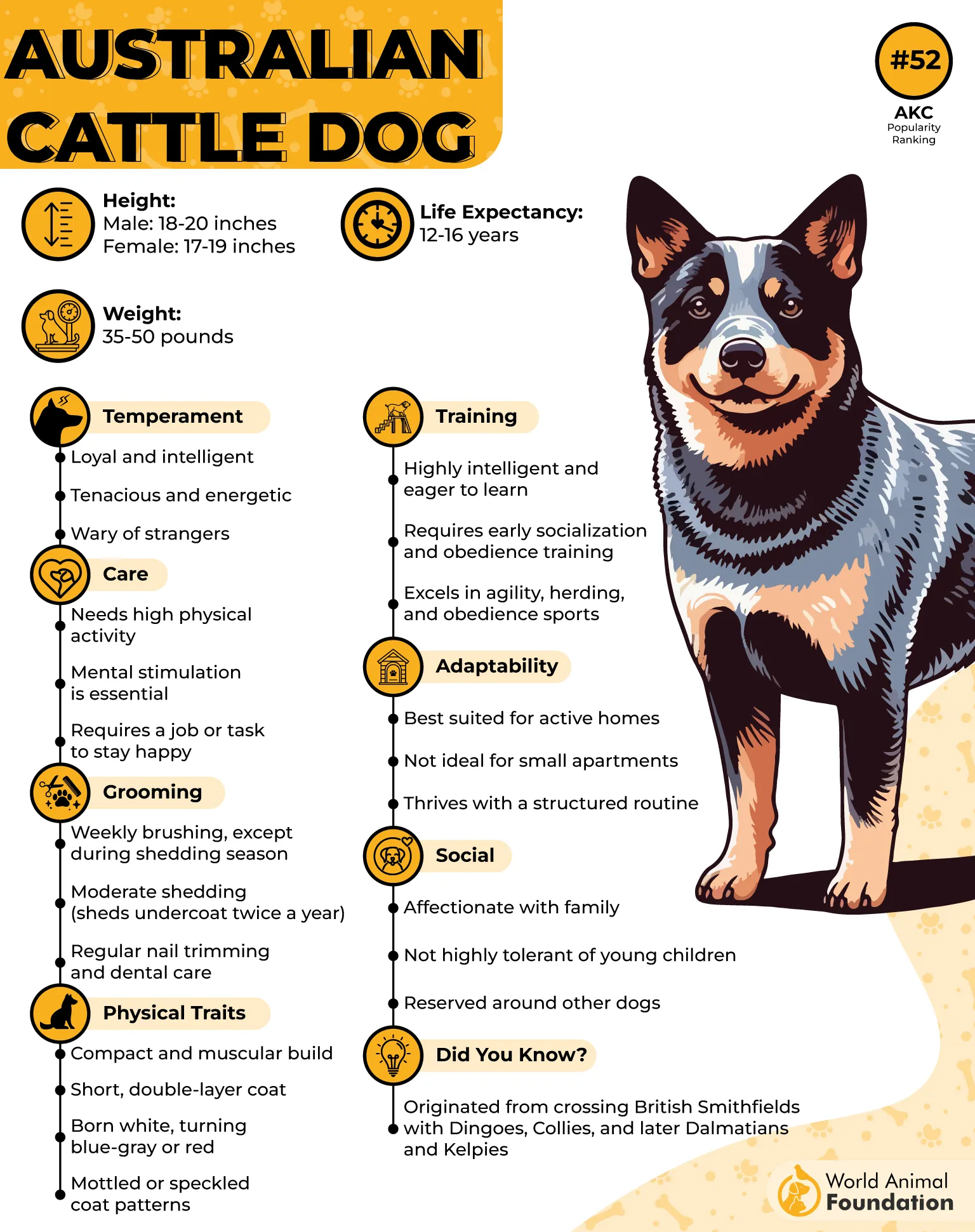
Despite their toughness, they can be prone to health conditions like hip dysplasia and progressive blindness. Regular health screenings and weight management help extend their life span.
These dogs require consistent training from an early age. Their loyalty is unmatched, but they need clear boundaries and daily structure to stay balanced.
Not for the fainthearted, Cattle Dogs thrive in homes with experienced owners and plenty of outdoor time. They tend to bond deeply with their family and may be reserved with strangers.
Fun Fact
The oldest known dog ever, “Bluey,” was an Australian Cattle Dog who lived an incredible 29 years, according to the dog years chart!
9. Chihuahua
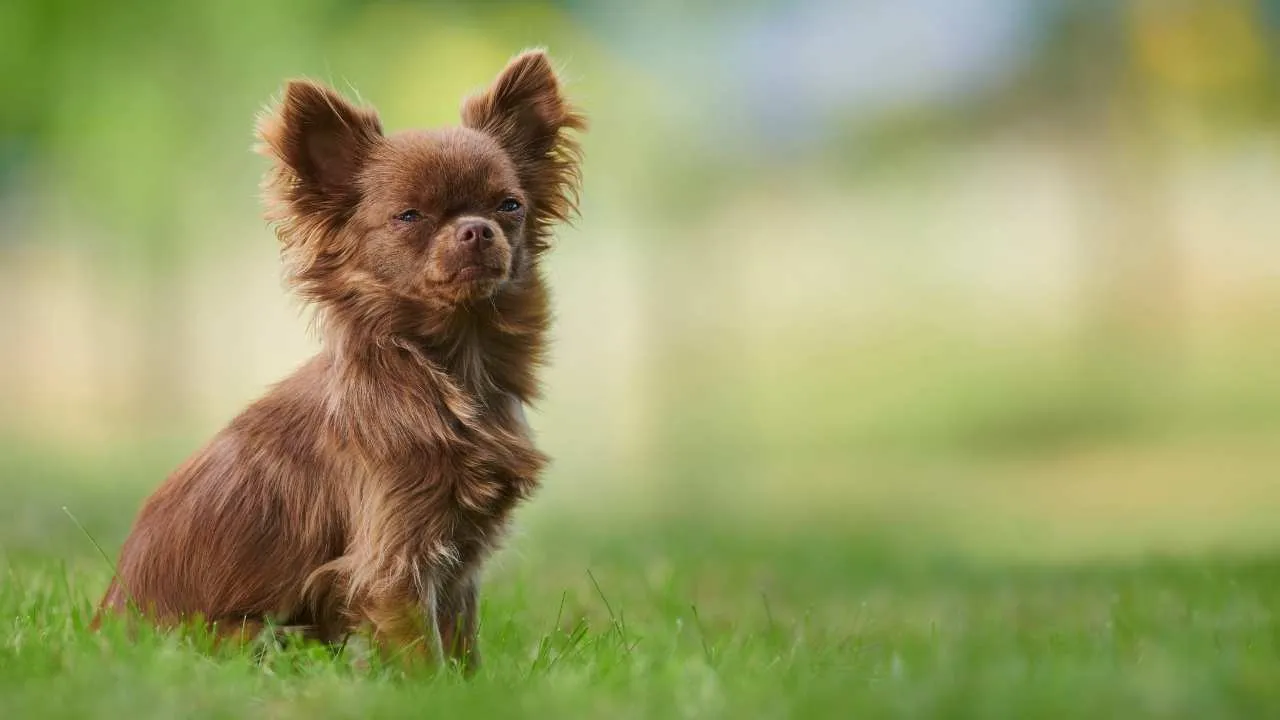
The Chihuahua is one of the smallest and longest-living dog breeds, often reaching 14–17 years or more. Their compact size, spirited personality, and loyalty make them a popular toy breed choice for many.
Don’t let their size fool you—Chihuahuas are known for their bold attitude and big bark. They’re incredibly alert, protective, and often form intense bonds with one or two people.
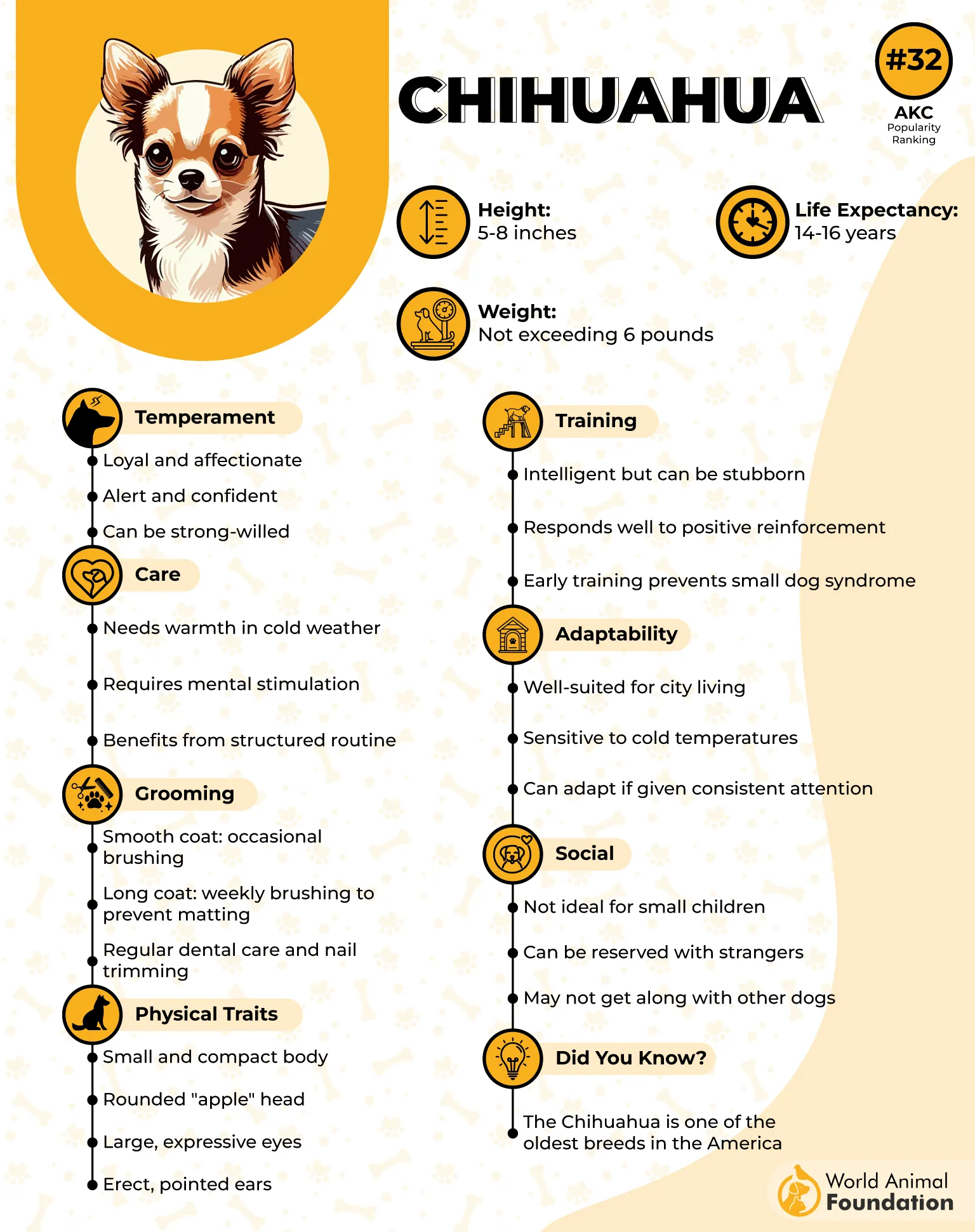
These tiny dogs require regular exercise, even if it’s just short walks or playtime indoors. Without stimulation, they can develop behavioral issues, especially if overly babied.
Common health concerns include dental disease, heart issues, and luxating patella. Regular veterinarian visits and maintaining good dental hygiene are key to their long-term well-being.
Chihuahuas do well in apartments but need socialization early to avoid becoming overly wary or snappy. They’re also prone to being chilly—cozy sweaters aren’t just fashion!
Fun Fact
In “dog years,” a 15-year-old Chihuahua is like an 80-year-old human—but they often still act like feisty puppies well into their teens.
10. Maltese
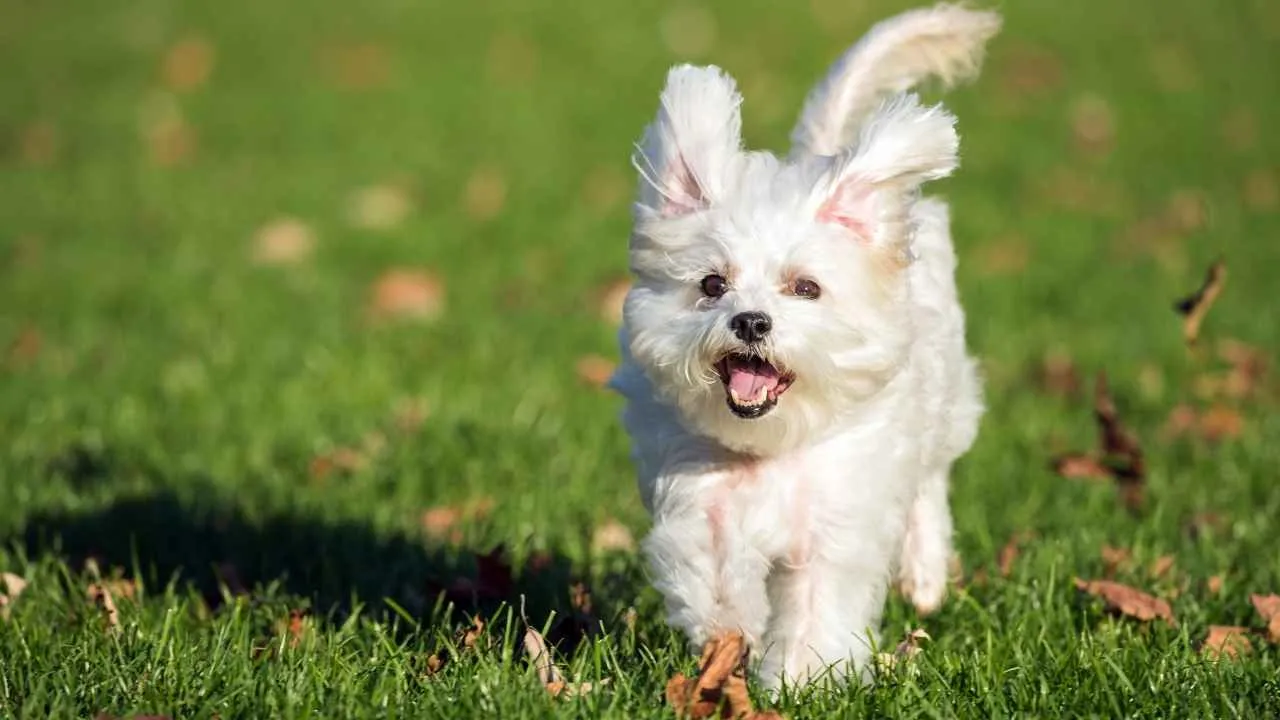
Elegant yet playful, the Maltese is a gentle small breed with a surprisingly long life expectancy of 12–15 years, some even reaching 18 with exceptional care.
This ancient breed has a long, silky white coat that gives it a royal look, but underneath is a vibrant, affectionate dog who thrives on human companionship.
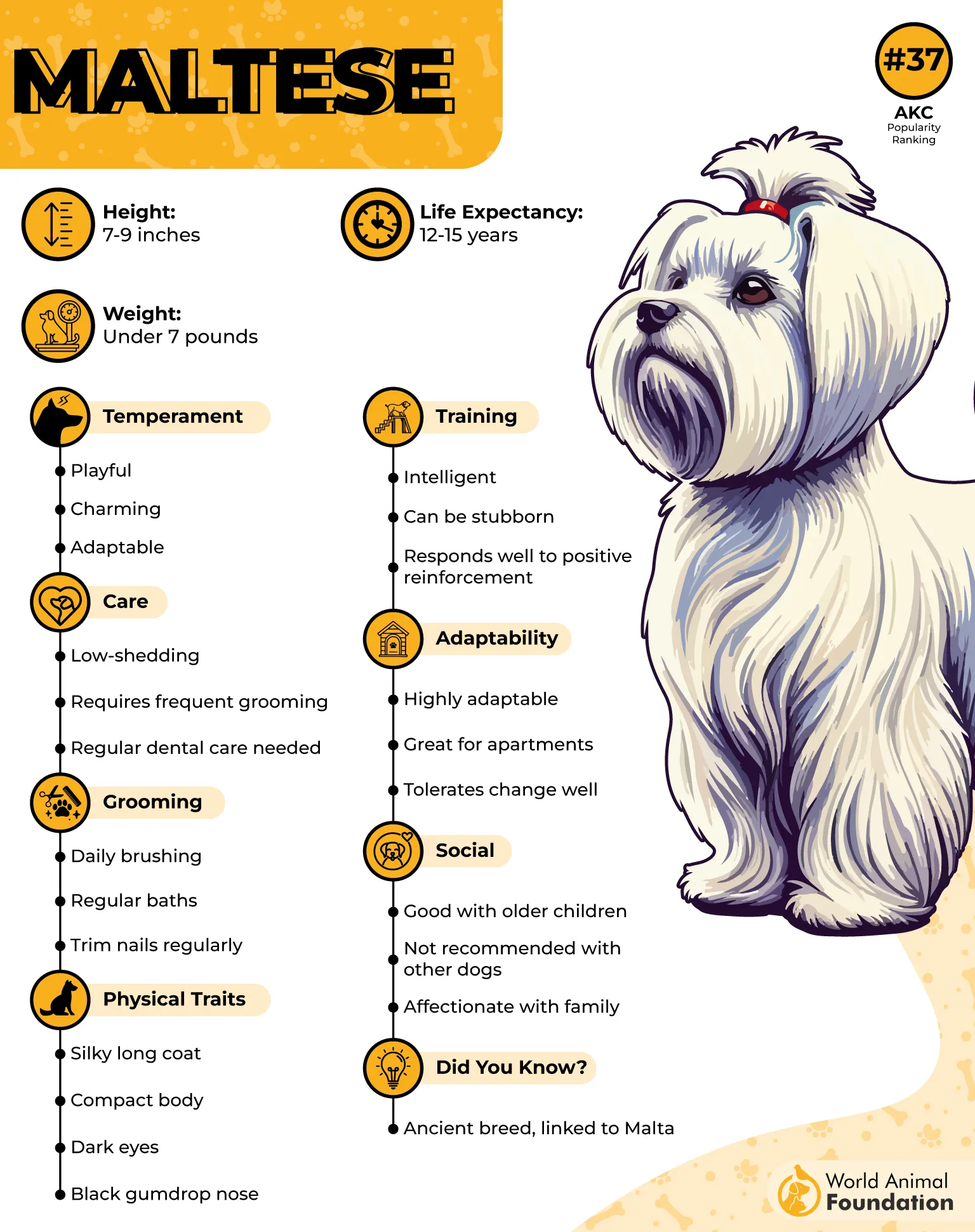
Despite their dainty appearance, Maltese dogs are quite hardy. With proper grooming and veterinarian support, they can avoid common health issues like dental problems and a collapsed trachea.
They do best in homes where they aren’t left alone for long. Their sociable nature makes them perfect lap dogs, but they still need light daily exercise to stay trim and happy.
Their size and sweet temperament make them excellent companions for seniors and families alike. They rarely shed and are considered hypoallergenic by many dog lovers.
Fun Fact
The American Kennel Club ranks the Maltese as one of the oldest toy breeds, with lineage tracing back over 2,000 years to the Mediterranean.
Conclusion
Many dog breeds are known for long lives, but health, care, and lifestyle play major roles too. In our roundup, breeds like the Miniature Schnauzer, Dachshund, Chihuahua, and Australian Cattle Dog stood out among the most long-lived dog breeds. Remarkably, the oldest dog on record—Bluey—was a Cattle Dog who lived to 29.
We didn’t cover all of them, but others like the Toy Poodle, Yorkshire Terrier, Chinese Crested Dogs, Shih Tzu, Boston Terriers, Lhasa Apso, and Bichon Frise are also known to live the longest. These energetic dogs often stay youthful with regular activity, proper vet care, and lots of love.
Interestingly, mixed breed dogs tend to benefit from broader genetics and may live just as long—or longer—than purebreds. So, while breed dogs matter, dogs tend to thrive when their entire body and mind are well cared for.
Whether you want a spirited terrier or a loyal lapdog, choosing breeds known to live longer increases your chances of enjoying many joyful years together. A healthy routine, balanced diet, and early health screenings are key to a long, happy canine life.


